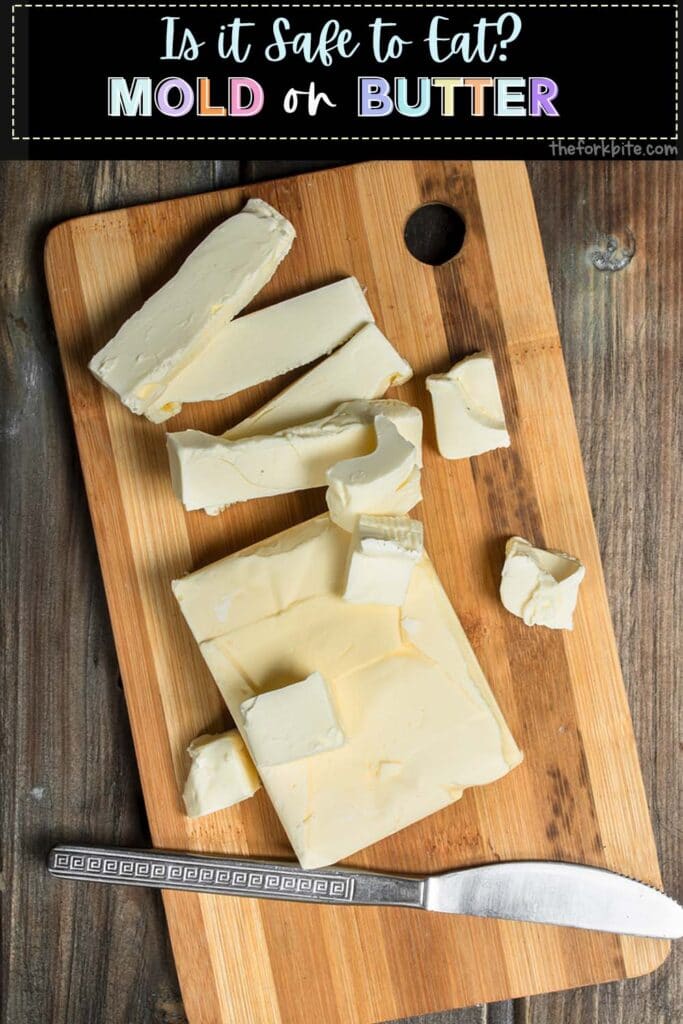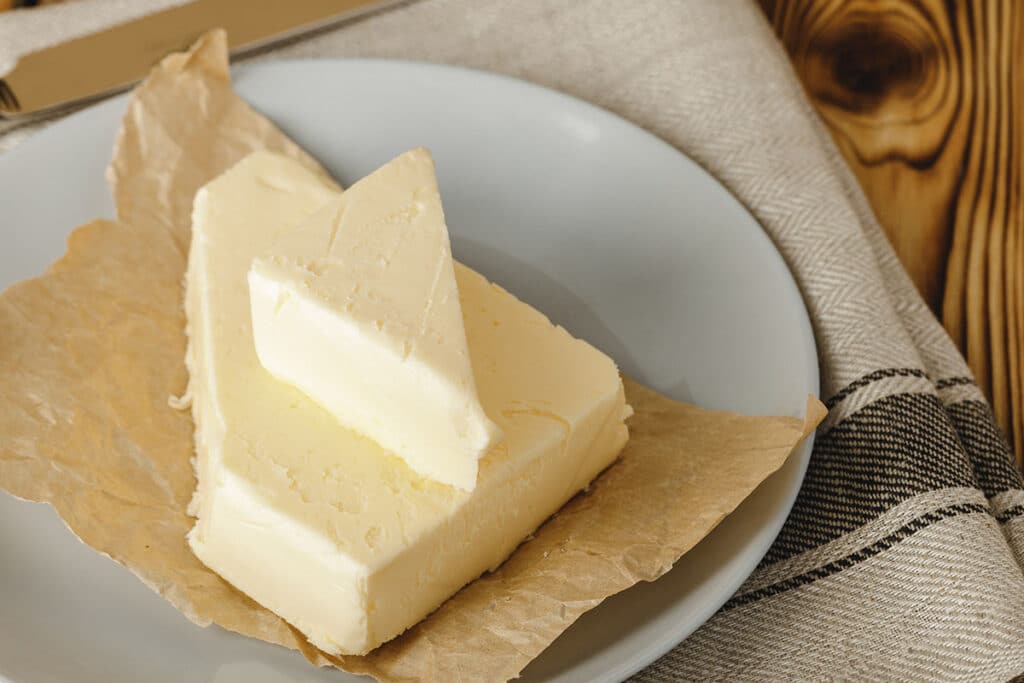Since butter is a natural dairy product and its composition seems to fly in the face of food safety laws, it is somewhat resistant to bacterial growth.
However, when exposed to heat, light, and oxygen for too long, this can cause it to become rancid.
To make it easily spreadable, many people store and serve butter at room temperature. But why should it be safe to eat? What about it turning moldy?
These questions worry many people, so I thought it would be good to write this article and explain why butter bucks the trend of many other foods.

What you should know about butter
You make butter by "churning" the cream of the milk. Here is an interesting video on Youtube of butter being churned on a small farm in Ireland.
In those days, it was hard, manual work. Today, the top butter-making nations are India, New Zealand, the EU, and the USA.
Butter is unparalleled due to its gorgeous creaminess and luxurious taste; food cooked in butter tastes absolutely delicious.
It is used for sauces, baking, and simply spreading on bread, toast, or crackers. Nothing else comes close.
Here are some interesting facts:
- The melting point of butter is 98.6°F.
- Its smoke point is 350°F.
- It can be stored at room temperature (short-term), refrigerated, or frozen.
- The shelf-life of butter is 1 to 3 months in a fridge or up to 1-year in a freezer.
Different types of butter
The two types of butter you will frequently find in your supermarket are ordinary unsalted butter and salted butter.
To which a small amount of salt has been added to act as a preservative.
Here is the breakdown of butter as we explain their differences.
1 Clarified butter and Ghee
Other butter products include clarified butter and Ghee, both made from pure butterfat, which has removed all or most milk solids.
You can heat these butter products to 450°F (the temperature recommended for making a roux) before they start to smoke.
The removal of the milk solids also gives these products and vastly extended shelf life.
Would you mind looking up the recently written article if you'd like to know more about clarified butter and Ghee?
Read: Clarified Butter Substitute

2 European Butter
Unadulterated European butter can contain as much as 86% fat. It is delicious, has less water, and is excellent for making flaky or puff pastry.
3 Sour or cultured butter
In mainland Europe, they also have cultured, or sour butter, slightly fermented to impart a slight tang to its flavor.
4 Light (reduced-calorie) butter
There is also something called "light butter." It has 25% less butterfat than regular butter and contains canola oil. It is lower in fat, calories, and cholesterol.
5 Organic Dairy Butter
This type of butter comes from the milk of cows that eat organically grown feed.
They spend much more of their lives grazing in open pastures.
Packs of organic dairy butter can be recognized by the organic logo printed on the packaging.
Read: Benihana Garlic Butter
6 Grass-fed dairy butter
This butter variant comes from the milk of cows whose feed is 75% grass.
Does eating moldy butter make you ill?
Yes, it probably will. Because butter is a soft product, once mold appears on the outer surfaces, it can easily penetrate deeply and quickly, distributing toxins throughout the butter.
The FDA classifies eating moldy butter as unsafe because the toxins it contains can damage your immune system.
If your butter develops mold on the outside, I recommend you eliminate it to avoid any potential health problems developing should you eat it.
Why is there mold on my butter?
Despite butter being a low-risk product in bacterial growth, the high-fat content makes it susceptible to turning rancid.
When fat begins to spoil, it will emit an unpleasant odor and will probably become discolored.
Oxidization and rancidity
Fat turns rancid because of oxidization. Oxygen causes the fat to break down into smaller particles known as fatty acids.
As this process progresses, it results in rancidity, creating a bad smell and a color change.
Oxidization creates free radicals, which can damage the cells, DNA, and proteins in your body.
Oxidization can accelerate aging and increases the risk of several chronic illnesses such as cancer, heart disease, and a variety of other inflammatory diseases.
As well as taking on a bad smell and discoloring, foods in which fat has turned rancid also taste gross.
Other causes of mold and rancidity
It's not just oxidization that causes mold and rancidity. Other things such as dirty utensils and exposure to heat and light can also increase the risk.
1 Light and air contribute to mold growth.
Light and air are both significant factors that can impact the growth of mold. That's why it is better to keep butter in an airtight container.
While it is impossible to stave off rancidity and mold in the long run, storing things in an airtight container can significantly delay the process, especially when it comes to butter.
2 Unsalted butter fares worse
The salt in salted butter helps to protect it from any fungal growth. Unsalted butter, however, is much more susceptible to fungus development due to the lack of salt.
Therefore, it is advisable that as soon as you've finished using your unsalted butter, you should return it to the fridge.
3 Problems with heat
When you expose butter to heat, it increases the likelihood of mold growth.
Once butter is left anywhere near a warm oven or in a warm environment, the dangers of mold growth increase.
If the temperature in your kitchen is 70°F or more, you should store your butter in the fridge.
4 Dirty utensils
Butter can spoil not only through chemical changes caused by things like oxidization but also through microbial intervention.
This can be easily introduced by the use of dirty utensils or containers.
Contamination may not be noticeable to the naked eye at the microbial level, so it is important to ensure that all utensils and containers are hygienically clean.
The fact of the matter is that when you unwrap butter for the first time, it is pretty much sterile.
But as soon as you begin touching it with your hands or other utensils, you increase the risk of contamination which will undo the safety of the pasteurization process that the butter went through.
When making clarified butter or Ghee, removing milk solids from butterfat makes the products much more stable and significantly increases their shelf life.
Dangers of moldy butter
Nobody likes food wastage. Because of this, it can be very tempting to scrape away an area of mold and consume what is left. It's not a good idea.
Suppose you read this article on the Wellandgood.com website.
In that case, it quotes Benjamin Chapman, Ph.D. (a professor and food safety specialist at North Carolina State Uni, who also hosts a food safety talk podcast), and it explains why.
The danger is the "threads when you spot mold (especially on soft food products like butter).
The danger is the "threads." They are like tentacles that penetrate deeper into the butter and contaminate areas that seem to be free of mold.
It's not likely to kill you, but mold contains toxic substances known as mycotoxins which can cause respiratory problems and allergic reactions.
That's why if you do spot mold on your butter, it's best to be safe rather than sorry and discard the whole block.
Is it okay to leave the butter out at room temperature?
Bacteria that result in food poisoning need a protein-rich environment to flourish. This is why you can leave an onion out at room temperature overnight, but not a piece of steak.
Butter contains around 80% fat, approximately 16% to 17% water, and only about 3% to 4% protein. It's not enough to encourage significant bacterial growth.
Salted butter is even more resistant to bacterial growth.
You can keep salted butter for weeks at room temperature, but frankly, most of us prefer to store it in the fridge and take it out when it's required, salted or not.
Difference between spoiled butter and rancid butter
A friend of mine keeps butter in her fridge month after month. She doesn't use it for cooking with, she's not much of a baker, and she spares on bread very sparingly.
It got me to wonder at what point will her butter become inedible?
Rather than mold, the biggest concern with butter is oxidization and turning it rancid.
Okay, it won't make you violently ill, but it won't smell or taste very appetizing.
An easy way of preventing or delaying rancidity is to store your butter in an opaque butter dish under a closed lid.
Opaque is better than clear since light is one of the factors that can spark off rancidity.
I usually leave the wrapper on my butter even when I put it into a butter dish.
Yes, it's partly laziness, but it also means less surface area for the air to get to, which is good.
It also makes the butter dish easier to clean. Every little helps, right?
Signs that your butter has gone bad
It's relatively easy to determine whether or not your butter has gone bad.
It will either be too soft or too hard, and it might have even grown mold.
To double-check, look for any discoloration, unpleasant odor, or taste.
Fear not; if you eat a tiny bit of bad butter, it won't do you any serious harm.
Look out for these signs:
1 Discoloring- fresh butter has a nice, even yellow color throughout. If you cut a slice and it appears somewhat brighter or lighter on the inside, it's probably gone off.
2 The appearance of black spots- unless you've accidentally spilled some ground black pepper on your butter, the appearance of black spots is a good indicator it's gone off.
3 Cheese is cheese, and butter is butter- If the butter starts to smell cheesy or sour, it's time to throw it out.
4 Weird texture- Spoiled butter usually turns very soft, mushy, or even stringy.
Storing butter to keep it fresh
A good food health and safety regime will go a long way towards keeping you safe from food health-related hazards and food poisoning.
Here are a few tips:
- Store butter in a covered container. Keep it in the coldest part of your refrigerator at a temperature between 32°F and 38°F.
- Don't be tempted to use the covered section behind your fridge door to store your butter. The frequent opening and closing of the door make it susceptible to temperature variation.
- Store butter in an airtight container or, if not, tightly wrapped in plastic food wrap and aluminum foil.
- If freezing butter, wrap it in heavy-duty aluminum foil or plastic food wrap and pop it into a heavy-duty freezer bag. As well as protecting your butter from the air, this will prevent it from absorbing any odors or flavors from other foods stored in the same freezer.
The expected shelf life of butter
- When you're out shopping for butter, you'll find it in the refrigerated section of grocery stores and supermarkets, and it will have a "sell-by date" printed on the wrapper.
- Don't confuse this with an expiry date. A sell-by date is only there for the benefit of the store owners so they know for how long they can keep it on display.
- You can keep unopened, unsalted butter for at least a month past its sell-by date in your refrigerator or for up to six to nine months in your freezer.
- Once it's opened, you can keep a block of butter in your fridge for up to two weeks. If you transfer it into a sealed container or butter dish, you can keep it at room temperature for two weeks.
- You can keep salted butter for up to 5 months in your fridge, and when frozen, you can keep it for one year.
- Flavored butter, sometimes referred to as compound butter, is mixed with herbs, spices, etc. You can keep it in the refrigerator for up to 5 days and up to six months if frozen.
The quality of butter will begin to decline once it gets past its sell-by date. If it is not stored correctly, it will eventually go off.
Good, hygienic sanitary food practices will help to ensure your butter remains fresher, longer.
Butter substitutes
If you're looking for butter substitutes for health reasons, the place to start is with what the problems are.
If you're concerned about someone who is lactose intolerant, then your best bet is going to be a dairy-free butter.
On the other hand, if your wanting to remove saturated fats from your diet, then cooking with coconut oil could be the solution you're looking for, rather than using butter or margarine.
In most scenarios, you can substitute coconut oil, including baking, frying, and even spreading on toast.
When searching for substitutes, there are lots of possibilities.
But the best one will probably depend on the recipe you're following and your own or your family's personal preferences.
- For frying and sautéing, coconut oil is an excellent substitute. Some of the top brands include Carrington Farms coconut oil, Crisco organic coconut oil, and Nutiva organic extra virgin coconut oil.
- When baking, vegetable shortening is another popular substitute. The only thing to bear in mind is that shortening is pure fat. If you go down this route, bearing in mind that shortening has 20% more fat by weight, butter brings extra water into the mix, which might affect the result.
- Other substitutes in terms of baking include the likes of applesauce, avocado, banana, and yogurt.
Softening butter for spreadability
It can be quite frustrating when you take the butter out of the fridge only to find that it's almost impossible to spread on nice fresh bread.
The best way to deal with this is to take it out of the fridge in advance and allow it to soften naturally at room temperature.
It usually only takes a few minutes but could take anywhere up to one hour, depending on the room's temperature.
It's best to only remove the amount of butter from the fridge that you intend to use, but whatever is leftover should be re-wrapped and return to the fridge as soon as possible.
Butter is very vulnerable and will pick up odors and flavors from other foods readily.
Store it in an airtight container or butter dish with a closed lid and keep it as far away from as possible from other aromatic foods.
Don't forget that heat and light can cause the onset of rancidity, so wrap it well so that air and light cannot easily get to it and store it in a cool dark place.




